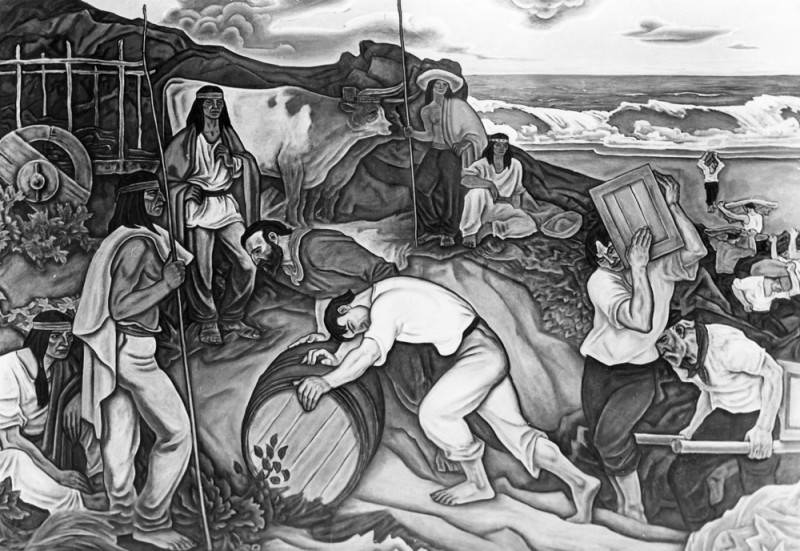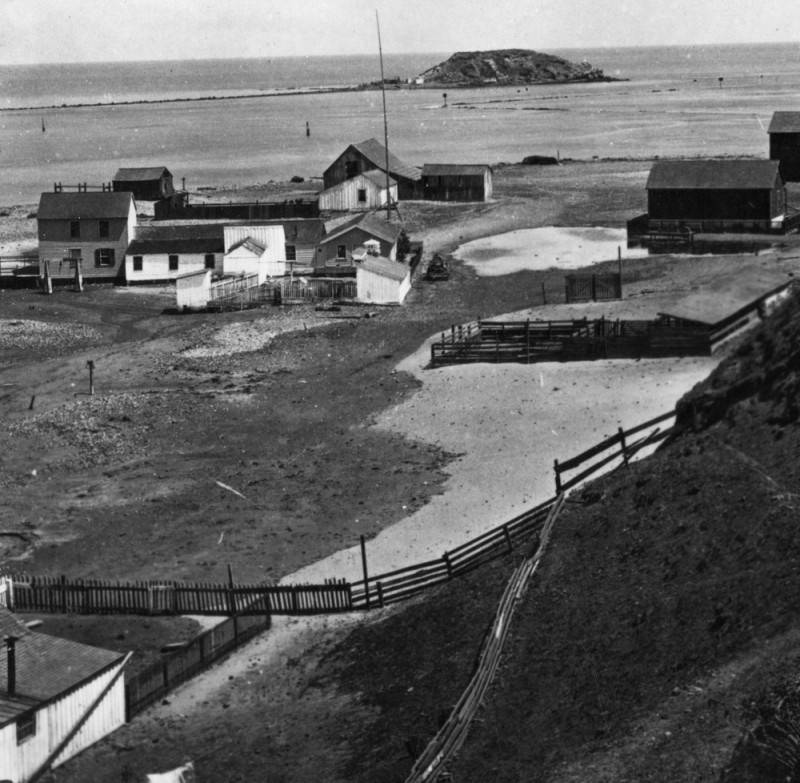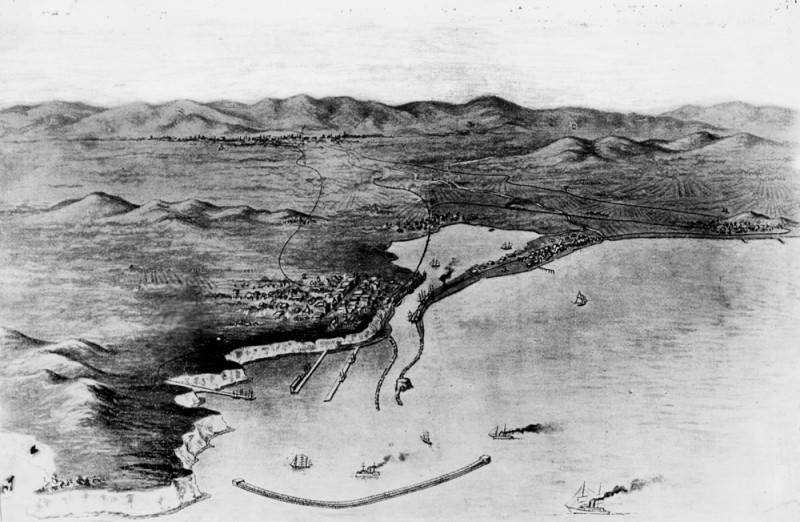Dead men do tell tales at times. Some have tales to tell about a small islet that once acted as a landmark in Los Angeles Harbor just off San Pedro. Photos in the library’s collection depict Deadman’s Island, or Isla de los Muertos, across nearly a century, while also giving glimpses at the rapidly evolving community of San Pedro. But don’t look for it now!
The earliest view we have of Deadman’s Island is this photo based on a daguerreotype by William Godfrey, dated 1850. Only the base of the island in the background can be seen. The very small collection of shanties is all that comprised San Pedro, at that time already the main port for the town of Los Angeles. Image #00033343, Security Pacific National Bank Collection.
Dana’s view
In 1836 Richard Henry Dana, a sailor by choice on the brig Pilgrim, described the island:
“…a small, desolate-looking island, steep and conical, of a clayey soil, and without the sign of vegetable life upon it; yet which had a peculiar and melancholy interest to me, for on the top of it were buried the remains of an Englishman, the commander of a small merchant brig, who died while lying in this port.”
Dana studied the island while guarding a stack of cowhides that his shipmates had just acquired from the local Californio ranchers. Hides and tallow were the lifeblood of commerce in Alta California, at that time a province of Mexico. It is likely that he heard the tale of the sea captain from the group of local men he spent time with that evening. He is able to provide lurid detail to the story:
“…the man died far from home; without a friend near him; by poison, it was suspected, and no one to inquire into it; and without proper funeral rites; the mate, (as I was told,) glad to have him out of the way, hurrying him up the hill and into the ground, without a word or a prayer.”
Dana must have speculated as to the cause of the man’s demise. His own skipper had a vile temper, and Dana describes many acts of cruelty, including floggings. He even admits to fantasizing about mutiny.
Detail from a WPA mural on display at Dana Middle School in San Pedro — It depicts sailors from Dana’s ship exchanging trade goods for hides. The Native Americans, in service to the rancheros, have brought the hides down by ox and cart to the seashore. In the background men are laboriously carrying the heavy hides down to the boats. The work of obtaining the valuable cowhides was called “hide-droghing.” Dana is famed for his book Two Years Before the Mast, a highly descriptive account of life in the days of sail. Works Progress Administration Collection, Adrien Machefert artist, c. 1929, Image #00070050.
Lost in translation?
Dana does not name the island and there is controversy about when and where the name “Deadman” or “Isla de los Muertos” (Isle of the Dead) first came into use. We know that sailing ships passed along the coast as early as the 16th century, including those of the well-known explorers Cabrillo, Drake, and Vizcaíno . It is possible, even likely that the islands and islets near to shore were used as convenient burying places for those who died at sea. We know that Cabrillo himself was likely buried on one of the channel islands, probably San Miguel, in 1543, after dying of gangrene.
Midshipman Robert Duvall of the USS Savannah believed he and his shipmates had first named the island. In his logbook, following the 1846 Battle of Dominguez Hills, he writes:
“Wm H. Berry, O.S. departed this Life from the effects of a wound received in Battle. Sent his body on “Dead Mans Island,” So named by us. Mustered the Crew at quarters, after which performed Divine Service.” [all punctuation sic]
There is also speculation that the original name of the rocky outcropping had nothing to do with death at all. One Narciso Botello (1813 – 1889), in his memoirs, refers to our island as Morrito. The editor of the published volume, Brent C. Dickerson, tells us that morrito is the diminutive of morro meaning “something jutting out” or simply “nose” or “snout.” One immediately thinks of the famed Morro Rock in San Luis Obispo County, a volcanic plug named by the explorer Cabrillo in 1642. According to the official website of the City of Morro Bay, the name means “crown shaped hill” in Spanish. If the 576-foot tall Morro Rock is a crown-shaped hill, perhaps the 55-foot tall Deadman’s Island was a smaller crown-shaped hill.
Yet other translations on offer for “morro” include dome, turban, and — perhaps the simplest of all — hill, in Portuguese. Cabrillo, after-all, was at least part Portuguese.
A similar view to that of the daguerreotype above, but taken some two decades later. A breakwater has been installed as an aid to navigation into the inner harbor and some temporary structures can be seen at the point where the island meets the breakwater. Security Pacific National Bank Collection, Image #00033342, 1873.
Our poor island’s name was taken in vain during the free port wars, beginning in 1889, when various interests vied for federal dollars to build port facilities at either San Pedro or Santa Monica Bay. Senator William B. Frye of the U.S. Senate Committee on Commerce had this to say about San Pedro:
“Deadman’s Island! Rattlesnake Island! I should think it would scare a mariner to death to come into such a place! You people in southern California propose to ask the government to create a harbor for you, almost out of whole cloth. The Lord has not given you much to start with, that is certain. It will cost four or five million to build, you say: well — is your whole country worth that much?” (quoted in Hager, “A Salute to the Port of Los Angeles…”)
Despite the senator’s misgivings, San Pedro was chosen to be the deep water harbor for Los Angeles County. This decision ultimately sealed the fate of the little island, as we will see below.
This circa 1905 view of San Pedro provides a much clearer view of Deadman’s Island, now connected by rock jetty to Terminal (or Rattlesnake) Island. The port town of San Pedro, while still quaint, has docking facilities and rail service. A dredger works at top left deepening the channel into the inner harbor. Security Pacific National Bank Collection, Image #00032600.
Toasting the dead
An interesting anecdote comes to us from one Horace Bell, a California ranger, who published his memoirs in 1881. It seems that Bell accompanied Juan Antonio Sepúlveda and a group of enthusiastic gentlemen on a little outing celebrating the Fourth of July in 1853. Sepúlveda was a prominent don who had served with José Antonio Carrillo in the California War. According to Bell:
“Don Juan, in the exuberance of his patriotism, had unearthed a venerable field piece which had enjoyed the silence of the grave since it had fired its last shot in defense of Mexican territory. Captain Sepúlveda mustered and embarked his command on a large boat and proceeded up Wilmington Bay, where he embarked his artillery and sailed for Dead Man’s Island, where, after infinite labor, he succeeded in mounting his battery on the highest point of the island, and all being ready, we let loose such a thunder as was never exceeded by one gun. It seemed that we would wake the seven sleeping heroes who so quietly reposed on the little barren rock…While paying our respects to our liquid ammunition, Don Juan proceeded to tell us how the seven sailors came to be killed. Their wooden head-boards stood in a line in front of us.”
The seven sleeping heroes were Americans who had been killed in the Battle of Dominguez Rancho, sometimes called the Battle of the Old Woman’s Gun, in October 1846. The battle between the American foot soldiers and sailors and a smaller force of mounted Californios had resulted in a rout of the Americans, largely due to the presence of an ancient piece of artillery brought to bear by the enemy (and later, allegedly, mounted by Sepúlveda on Deadman’s Island). It was the last true victory for the Californians before American forces made good their conquest of this outpost of the Mexican empire. One of the dead, a cabin boy, had been killed accidentally by friendly fire.
The little island, standing roughly where the the Americans’ ship, the USS Savannah, was anchored, proved a convenient place to deposit the remains of fallen comrades. The San Pedro coast was still closely watched by the enemy, not to mention coyotes.
This 1899 illustration depicts “San Pedro harbor as it will look when completed.” We can see a series of docks and jetties with Deadman’s Island clearly visible in the center, at the foot of the jetty connecting it to Rattlesnake Island. Security Pacific National Bank Collection, Image #00033175.
Reclaiming the dead
Primary and secondary sources detail a number of bodies interred on the island. Clearly the heroes of the battle were not alone. Some bodies were discovered in the late 19th century during the building of a jetty connecting the isle to Rattlesnake Island, really a large sand spit, just to the north in the harbor. Another story says that some young adventurers stumbled upon a coffin in 1893. At the time of the island’s demise, 1928-30, dynamite and bulldozers uncovered somewhere between 18 and 23 sets of remains. (The discrepancy could well be due to the intermingling of bones during or before the demolition.)
So who were these people isolated to a not-so-final burying place? Clearly all of them were buried far from home. Some may have lain in the ground for a century or more. Collecting up all the references we have been able to find, we come up with the following list (some duplication is entirely possible):
- The six sailors and one cabin boy of the USS Savannah, killed during the Battle of Dominguez Rancho in 1846.
- Black Hawk, one of the last members of the Nicoleño, the native people living on St. Nicholas Island in the Channel Islands who had been forcibly removed in 1835. Black Hawk died about 1845.
- Two males who appear to have been Spanish soldiers based on their attire. Some have dated these remains to the 17th century or even earlier.
- A blond female, buried next to the Spanish soldiers.
- A white male, possibly a smuggler. According to a fourth-hand tale, he washed up on the island and died of starvation, his body found by local fisherman early in the 19th century.
- An English sea captain.
- The wife of an American sea captain, Mrs. Parker (or possibly Morton), who died of tuberculosis on shore at the same time her husband and crew were drowning at sea. The year was 1858 and the ship was the Laura Bevan, a clipper schooner bound for Santa Barbara.
- A Native American woman.
- A man with an arrowhead through his head
- A passenger from a Panamanian ship in 1851.
- And, of course, pirates!
The diversity of the populace hints at the storied history of the rock. Deadman’s Island was not merely a convenient place for burial. It served a number of purposes over the decades, including (briefly) a whaling station, a place of youthful exploration, a hideout for rum runners during Prohibition, a possible location of pirate treasure or smugglers’ contraband, and — in the 19-teens — a filming locale for several silent movies starring Charlie Chaplin and Harold Lloyd.
What happened to the bodies? It is hoped that all the remains collected before and during the demolition of the island were re-interred elsewhere. Unfortunately, we cannot be sure. Certainly we can be sure that most were never identified. The earthly remains of the Americans from the Battle of Dominguez Hills are said to have been reburied at the Presidio in San Francisco. Others may have been repatriated to onshore cemeteries.
A dredger at work on the demolition of Deadman’s Island, 1928. Security Pacific National Bank Collection, Image #00033162.
The hand of man
Deadman’s Island performed its last service as a sacrifice for the greater good. The building of breakwaters and jetties in the late 19th century had already taken a toll on the rock when the powers to be decided to remove it entirely to accommodate expanded port facilities. Dynamite and bulldozers did their work, leveling the islet and using the detritus as landfill to expand the flat Rattlesnake Island, at this time dubbed Terminal Island after the Los Angeles Terminal Railroad. The interests of commerce and industry were well-served: today the Port of Los Angeles, centered at San Pedro, is the top sea port facility in this country, measured by volume and value of goods shipped.
1928 aerial view of the harbor. Deadman’s Island is gone and a rectangular extension to Terminal Island is being created out of the remains. Security Pacific National Bank Collection, Spence Air Photos, Image #00033126.
Sources for this post include:
- Horace Bell, Reminiscences of a Ranger, 1881, via Kindle Books.
- Brent C. Dickerson, Editor, Narciso Botello’s Annals of Southern California 1833-1847, 2014, via Google Books.
- Robert Carson Duvall, “Extracts from the Log of the U.S. Frigate Savannah,” published in California Historical Society Quarterly, vol. III, no. 2, July 1924, pp. 105-125, via University of California Press.
- Sam Gnerre, “The islands of L.A. Harbor: Dead Man’s Island and Rattlesnake Island,” South Bay History, October 20, 2018. http://blogs.dailybreeze.com/history/2018/10/20/the-islands-of-l-a-harbor-dead-mans-island-and-rattlesnake-island/?doing_wp_cron=1560277090.0865828990936279296875.
- J.M. Guinn, A History of California and an Extended History of Los Angeles and Environs, 1915, via Google Books.
- Anna Marie Hager, “A Salute to the Port of Los Angeles from Mud Flats to Modern Day Miracle,” California Historical Society Quarterly, vol. 49, no. 4, 1970, pp. 329–335, via JSTOR.org.
- Nathan Masters, “The Demise of Dead Man’s Island, Lost Landmark of L.A.’s Harbor, KCET: Lost L.A., March 14, 2014, https://www.kcet.org/shows/lost-la/the-demise-of-dead-mans-island-lost-landmark-of-las-harbor.







